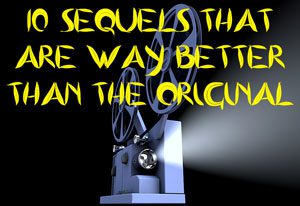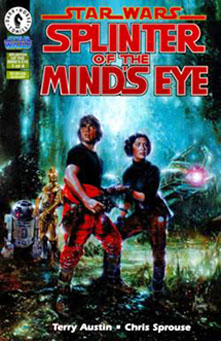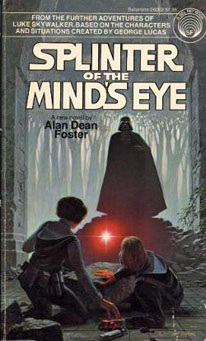Alan Dean Foster’s “Splinter of the Mind’s Eye” (1978), the very first “Star Wars” Expanded Universe novel, has somewhat of a murky reputation. It’s been criticized for hinting at a romantic relationship between Luke and Leia, having Vader duel Luke (and Leia!) before “The Empire Strikes Back,” and other minor oddities, such as Vader having a blue lightsaber (apparently, in early prints of “Star Wars,” the redness of his saber wasn’t clear).
But there is a lot to recommend “Splinter.” For one thing, it has the historical significance of being the very first crack at a further adventure in book form. Some behind-the-scenes details, which can be found on the Wookieepedia entry, make it intriguing, too: The book was a backup idea for a film sequel in case it had to be made with a low budget and without Harrison Ford (Han Solo is never mentioned by name in this novel, and he’s only referenced once). It features the Force-enhancing Kaiburr crystal from earlier drafts of “A New Hope,” so either Foster had access to those scripts while ghost-writing the “Star Wars” novelization, or George Lucas asked Foster to use the crystal in “Splinter.”
It has the odd-but-intriguing final battle. First, Leia duels Vader, then Luke — when freed from beneath a fallen stone — takes a crack at him. Vader toys with them the whole time, but seems like he’s still willing to kill them until he falls into a bottomless sinkhole (a common danger on the planet Mimban). It’s not the most crisply written part of the novel, but a reader can do a bit of mild retconning and argue that the crystal enhances Leia’s and Luke’s abilities — it’s also suggested that Obi-Wan helps Luke from beyond the grave — and that Vader holds back a bit because he suspects Luke is his son (he knows Luke’s name here, so this novel takes place after the events of Marvel No. 35 and “Vader’s Quest,” which I wrote about in previous posts).
But the real reason “Splinter” is a great novel is because of the chapters leading up to that grand finale teased by the cover art. Mimban is an evocative planet: It features a handful of mining towns, but is mostly fog-shrouded, swampy wildnerness peppered with temples of long-extinct beings. At 199 pages, it’s a delicious old-school sci-fi pulp adventure that can be read in two or three sittings, just like the other six “Star Wars” novels of the ’70s and ’80s (the “Han Solo” and “Lando Calrissian Adventures” trilogies). Danger abounds in every chapter; as a kid, I found this to be a grim tale that was almost too intimidating to read, but on this reading, I loved visiting this world and seeing Luke and Leia grow stronger through the adversity while gaining new allies like Force-sensitive old woman Halla and a couple of gigantic Yuzzem. (C-3PO and R2-D2 are also on hand.)

The characterization of Luke is spot-on, but Leia’s is unlike other EU works. The almost preternatural confidence that Lucas infused in Leia is not present here; instead, Luke is clearly the point man on this adventure, with Leia often the scaredy cat. She even whines about her clothes being covered with mud. I like Foster’s characterization of the princess, though; it suggests that while Leia is confident in diplomatic settings, she’s not quite as confident out in an untamed wilderness. Yes, she handled a blaster well on the Death Star, but Mimban is an even more unpredictable, deadly environment. Foster makes her more than a one-note character: Leia follows an arc of increasing confidence, taking a sniper shot at Vader and barely missing him, and later — fully expecting to die — dueling him with Luke’s saber.

Even years after its publication, “Splinter” had its admirers, and among them was Dark Horse Comics, which brought the novel out of the gloom of our imaginations to visual life in 1995-96 with Terry Austin and Chris Sprouse’s faithful four-issue adaptation. “Splinter” has the distinction of being one of only five “Star Wars” novels adapted in comic form. (Today’s trivia challenge: Name the other four. Hint: I’m not including “Shadows of the Empire” on the list, as that was not a strict novel adaptation.)
Still, if you have to choose one form to read “Splinter” in, go with the novel. Usually, a picture is worth a thousand words, but in this case, Foster’s pulpy sci-fi descriptions paint many great pictures in a reader’s mind.

